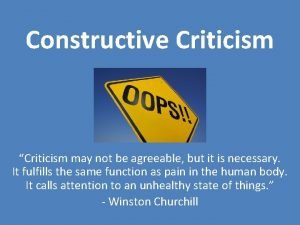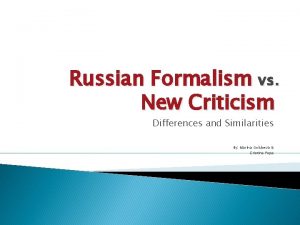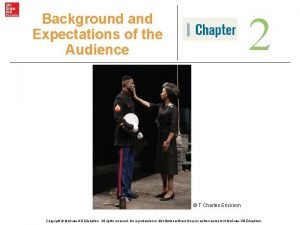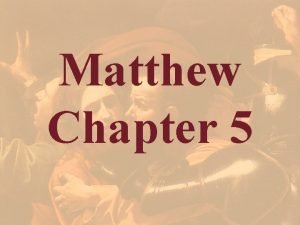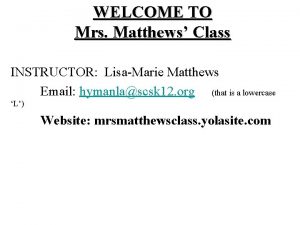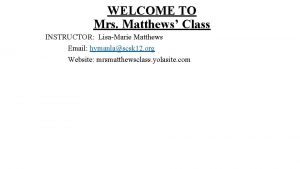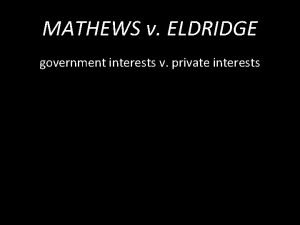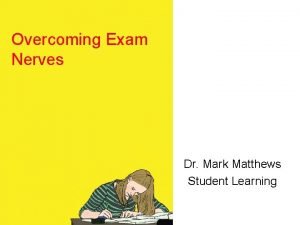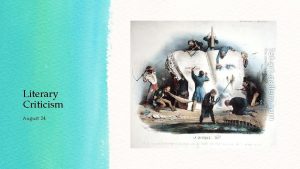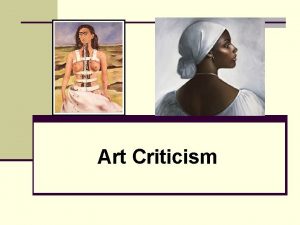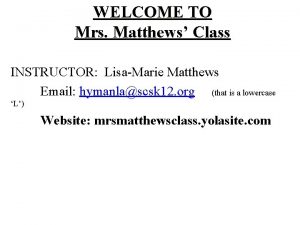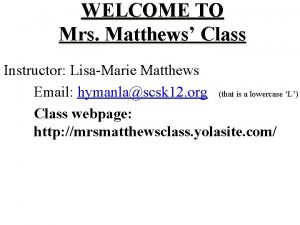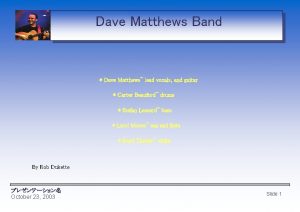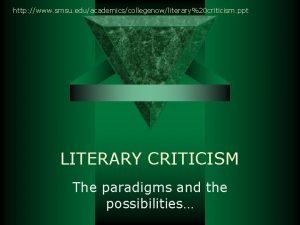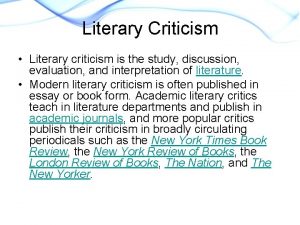Social Scientific Criticism Dr Victor H Matthews Social























- Slides: 23

Social Scientific Criticism Dr. Victor H. Matthews

Social Scientific Criticism • Social-scientific criticism is an exegetical method that attempts to explore the original social and cultural setting of a text through clues in the text’s content and rhetoric and through the analysis of other ancient evidence. Emphasis in this method is less on the individual author and more on the social community within which s/he lived and communicated, because meaning is understood as a socially-constructed phenomenon.

Method • Assume the posture of a "respectful traveler" visiting a foreign country. Accept that the customs and social organization of the text you are visiting are foreign (etic viewpoint); prepare yourself to suspend judgment until you have observed the new phenomenon and tried to understand it in its own social context.

Method • Choose an institution in which you are interested (family/kinship, economics, politics, religion) and read some social scientific analysis of how such institutions were constructed in antiquity. Socialscientific critics build models of the dynamics of such institutions. Choose such a model, and then apply it to your text.

Kinship • "family" is construed in a variety of ways, and "blood-ties" are often metaphorical constructs for other types of association • A dynamic view of kinship transactions and their social significances may come from: --living arrangements (the use of space and social networks) --cultural constructs of "family"—including patronage and friendship, and marriage strategies

Method • Choose a social dynamic rather than an institution, and examine its relevance for your text. • Keep in mind the difference between emic and etic interpretations

Honor and Shame • Honor is a claim to worth that is socially acknowledged. It is gained or lost in the social struggle for power and in the exercise of gender roles and relations. • For men, honor is asserted in the public sphere. For women, honor is preserved in the private sphere; women are kept at home, and their bodies are reserved for the exclusive use of their husbands. If a woman is "shamed" (i. e. through rape), her husband or father is considered the true victim.

Group Identity vs. Individual Identity • Ancient peoples placed less emphasis on the individual, on one’s psychology and personal development. Instead, people defined themselves by the groups in which they were embedded, or to which they belonged. Whatever characteristics were associated with your group(s), they were also assigned to you as part of that group automatically.

Social Status and the Limited Good • Social status was determined by where one fell on the social hierarchy. The ruler was on top, followed by the retainer class (scribes, soldiers), the priests and the merchants. Together, these groups represented only about 2 -5 % of the population. The other 95 -98% were artisans, peasants and marginal people (slaves, prostitutes, beggars, cripples).

Social Status and Limited Good • In order to preserve their status, rulers considered themselves responsible for the populace in times of crisis. They distributed bread and heard the cases of the destitute who had no other legal recourse. Such magnanimity ingratiated the wealthy to their local subordinates and kept potential social tensions to a minimum. There was a whole web of such social interrelations between relatively wealthy benefactors and their social clients.

Purity and Pollution • Reality was imagined to have a particular arrangement or order. When that order was compromised, the result was "impurity" or pollution. Ancients devised ways to restore order after such pollution, through purification rituals, validation of authentic genealogical lines, scrutiny of sacred texts to determine the proper order anew.

Ritual Purity • In antiquity, pollution could be contracted from exposure to disease or a diseased person and from occasions of natural bodily emissions; one could become defiled by sin and by the sin of others; one could pollute oneself and the nation by marriage to a foreigner or by exile in a foreign land; the temple could become unclean if a statue of a foreign god was put within its walls. Notice that the boundaries being violated can be either bodily (disease, emission), social (marriage), or geographical (exile, the temple as the preeminent sacred space).

Spatality • “firstspace”: those concrete items that can be mapped and which society perceives are “geophysical realities” • “secondspace”: imagined space • “thirdspace”: which can be thought of as “lived space”

Equations of Spatiality • Space + Persons with Access to that Space = Accepted Social Actions Within that Space • Concentric Zones Established Within a Larger Space Demarking Selective Admission Areas • Space + Activities that Occur in that Space = Domestic, Economic, and Political Connotations of that Space

Jeremiah 36 • Baruch reads a scroll in temple chamber of Gemariah (v. 10) • Baruch reads the scroll in “the secretary’s chamber” in the palace (v. 11 -15) • The scroll is read by a royal advisor to Jehoiakim in his “winter apartment” (v. 21)

Positioning Theory • Replaces the notion of "role" with "position” • One's position in space and in relation to others is ever-changing • Individuals locate themselves in everyday conversations relative to personal positioning, institutional practices and societal rhetoric

Positioning Elements in 1 Kgs 22: 10 • Two Kings vested in robes of office • Thrones placed at the gate of Samaria on what had been a threshing floor • 400 prophets dancing about and proclaiming a military victory

Ruler’s Podium in the Gate

Samaria


Bab edh-Dhra Tombs

Bab edh-Dhra Tombs

Bab edh-Dhra Tombs
 Dr victor matthews
Dr victor matthews Two types of historical criticism
Two types of historical criticism Constructive vs destructive criticism
Constructive vs destructive criticism New criticism vs formalism
New criticism vs formalism Descriptive criticism vs prescriptive criticism
Descriptive criticism vs prescriptive criticism Matews planck
Matews planck Anne matthews dcu
Anne matthews dcu Baldwin
Baldwin Sriap
Sriap Mandy matthews nhs england
Mandy matthews nhs england Loop en val
Loop en val Emiko's cat often meows for food
Emiko's cat often meows for food Roy mathews bainbridge
Roy mathews bainbridge Matthew chp 5
Matthew chp 5 Carley matthews
Carley matthews Dr eloise matthews
Dr eloise matthews Donna matthews jarrell
Donna matthews jarrell Mrs matthews website
Mrs matthews website Lisa marie matthews
Lisa marie matthews Mathews v. eldridge balancing test
Mathews v. eldridge balancing test Survey monkey accessibility
Survey monkey accessibility Matthews waste disposal
Matthews waste disposal Kent matthews
Kent matthews Dr. mark matthews
Dr. mark matthews


